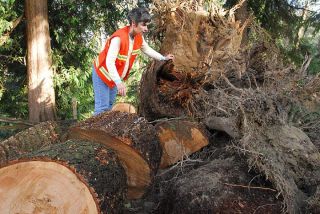While hundreds of trees fell to the ground during the 60-plus mph winds that gusted through the Island last week, countless still remain standing tall.
However, any tree that is leaning or looks dangerous should be assessed and possibly removed as soon as possible because they are potential threats to public safety.
“If a tree is leaning then it should have a second look,” one of the city’s three arborists, Kathy Parker said. “Also if there are cracks in the soil near the roots or mounting soil, an assessment is needed.”
Since the storm, Parker has been all over the Island looking over fallen or leaning trees on residential properties. She is the city’s private property arborist, the person who determines if a tree should be cut down when a property owner requests tree-cutting permit.
Two other arborists work for the city. Paul West works with the Parks Department to make sure the trees in city parks are healthy and strong. Jimmi Maulding is the right-of-way arborist. If a resident has concerns of a tree on public property he inspects it. In 2005 the city removed 37 trees on public property and has taken down 28 this year.
Residents are required in some cases to get a tree permit according to the city’s tree ordinance. Private property owners don’t need a permit to cut any tree located outside a critical tree area, such as a steep slope or near a stream. No permit is required to cut any small tree either. Plus, pruning does not require a permit. A permit is required to cut down a tree for construction work or landmark trees and will only be granted if “it is necessary for public safety, removal of hazardous trees or removal of diseased or dead trees.”
Property owners can cut down a tree without a permit if there is an emergency, such as any leaning trees resulting from the wind storm. This exception only involves trees that pose immediate dangers to human life or property. After cutting a dangerous tree, Parker must be notified within seven days and must be provided additional information if requested. Then, a permit has to be obtained 20 days after the cut if it would have normally been required.
“The ordinance really covers only a few trees to speak of,” Parker said. “If someone is concerned of a tree on public property, or in the right-of-way, then they can call the city and somebody will look at it. If they are concerned of a tree in a construction site or in a critical area, they can call me and I’ll come take a look.”
Only certain trees are included in the ordinance because the city reduced the number of regulations when the tree ordinance was re-written in 2002. The provisions of ordinance require private property owners to obtain tree permits only for new construction that includes over 500 square feet of impervious surface, and removing trees in critical areas.
The ordinance does not prevent Puget Sound Energy from trimming trees near power lines, city communications coordinator Joy Bueling said.
In a press release issued by the Washington State Department of Natural Resources, the state warned homeowners that waiting to have a tree inspected is better than having it weakened by hastily hiring an uncertified tree trimming or removal company.
“Care needs to be taken to prevent over-reacting and removing large trees that may still be sound,” said Jim Flott, the educational director of the Northwest’s chapter of International Society of Arboriculture. “Standing trees with some branch damage should be evaluated by a certified arborist before a removal decision is made.”
State arborists are also concerned that clean-up attempts and ill-suggested trimmings may make healthy trees more dangerous. After the 1962 Columbus Day storm, many residents within the region had trees improperly trimmed or topped, the practice of removing large branches and tops of trees, and those are now more likely to fall in a wind storm.
“A previously topped tree is much more likely to break or uproot in a storm than a tree that has normal branch structure,” the press release from the Department of Natural Resources read.
Uncertified tree trimmers are expected to be encouraging home owners to have their trees trimmed or topped as a result of the extensive tree damage and number of fallen trees after this storm, experts say.
“Be sure to call a certified arborist,” Parker said. “They will come out and make a visual assessment and if they think more inspection is needed then they can do that. We are trained to look at three parts of the tree; the crown, the trunk and the root mass. What we’re looking for is anything abnormal or what may be a red flag. Some of those maybe shorter needles in the crown or cracks or conks in the trunk.”


